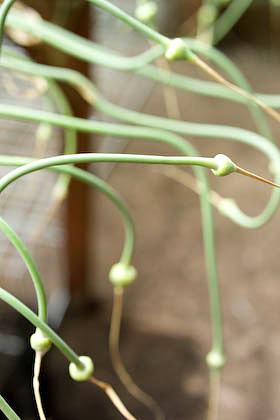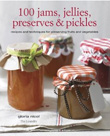SUMMER THROUGH ROSE TINTED SPECTACLES
Tuesday July 10th 2012, 6:37 pm

For anyone reading this in sunnier climes, in the UK it has rained and rained and rained. Other countries have their rainy seasons but our monsoon season always comes as a complete surprise. Even the most determined gardeners have had their endeavours thwarted by perpetual rain. Food producers have lost their crops on flooded land. God forbid, we’re all set for a scarcity of potato crisps in the months ahead! Whatever happens, food is bound to cost us more.
I’d been waiting for a dry sunny day to go and harvest the fruit on my allotment. Despite my lack of horticultural effort this year, I have been rewarded with a fair amount of produce. The berries would no doubt have benefited from a bit more sun, or any sun, but a few days ago I was still able to pick strawberries, raspberries, white, pink, red and black currants, gooseberries and even a handful of alpine strawberries. The currants were tedious to pick and the red ones turned mouldy in an instant, before I had time to get them in the pan. So sad as they are such a glorious fruit. There are still more white currants to harvest as patience got the better of me after stripping 5 bushes. This is my first year of any kind of crop as the bushes were planted just a few years ago.
The pink currants are particularly beautiful and as this is my first opportunity to preserve them I was curious to see whether their marvellous colour would follow through in a jam. They are a variety called Gloire de Sablon. I made the simplest jam with them, just berries, sugar and water, pushed through a food mill to remove the seeds, but not dripped in a jelly bag which would have given a clearer result. The jam has the look of a jelly but with just a tad more texture, a bright tangy flavour and will be eaten with relish on toast for breakfast. All currants contain plenty of pectin, the stuff you need to help jam set, so achieving a firm set shouldn’t be a problem.
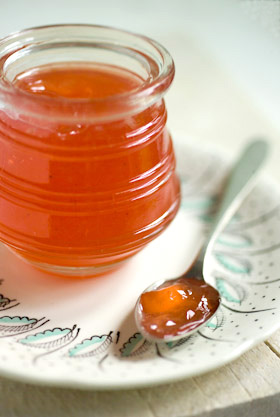
PINKCURRANT JAM
Makes approx 750g (3 x 1/2 pint jars)
550g (1 1/4lbs) pink currants
500g (1lb) sugar
300ml (1/2 pt) water
Place all the ingredients in a pan and bring slowly to a simmer, stirring all the time until the sugar has dissolved. Simmer for 5-10 minutes until the currants are cooked and burst. Take the pan off the heat, pour the contents into a bowl and leave covered overnight.
Next day push the currants and syrup through a sieve or food mill, collecting the juice and puree in a bowl underneath. Prepare your jars by sterilising them and their lids in a warm oven for 15 minutes or alternatively prepare a water bath, preserving jars and seals, if you plan to process (can) your jam.
Place the puree and syrup in a preserving pan, bring to a rolling boil and maintain to setting point, which should only take around 5-10 minutes. Skim to remove any froth from the edges of the pan, then pour into hot jars and seal. Alternatively, pour into hot preserving jars, seal and water process for 5 minutes. Remove from the water bath and leave to cool for 24 hours before testing the seals.
TIME TO PICK LAVENDER
Thursday August 04th 2011, 12:02 am
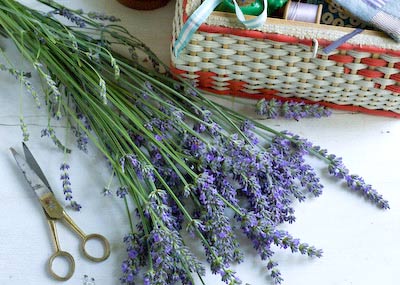
The other day whilst walking back from the preserving garden I suddenly caught a whiff of lavender on the breeze. Looking to the house alongside me, I could see through to a garden where there were two long hummocks of the stuff, running the whole width of the lawn, all in full spikey bloom and an intense shade of purple. The bees were having a field day. It was well worth stopping to breathe in another purposeful whiff before going on my way. Lavender is in flower so fleetingly, and it reminded me to harvesting some to dry for the linen drawer as well as some for culinary use. As a little goes a long way, plants in the garden at home, though nowhere as lush as those I had passed, would yield quite enough for drying without leaving them noticeably shorn.
It isn’t a crop that requires much in the way of pest control so is easy to grow organically. All the better for flavouring ice cream, buttery biscuits and cupcake icing. But a lightness of touch is most definitely required, as you can easily have too much of a good thing and end up with an overpowering medicated result. The flavour needs to be just there but hardly discernable, so getting the balance precise can be tricky. True lavenders, such as Lavandula augustifolia, including the popular Hidcote and Munstead varieties, are best for this, whereas the lavender hybrids called lavandins, bred especially for their oil are best avoided, as they are more likely to leave a strong camphorous aftertaste if used to flavour food.
Ideally picked on a dry sunny day when the flowers are just on the cusp of bursting open, you only need to tie a bunch together with string and hang it upside down, somewhere dry and shaded for the flowers to dry out in no time. When completely dried through, just crumble the brittle flowers away from the stems and store them in a sealed jar alongside your other herbs and spices. You could then use some to make my lemon, fig and lavender marmalade, which is featured in my friend, Canadian writer and canner, Sarah B Hood’s new book We Sure Can available in the UK from September. I’ve also just made some Blaisdon plum and lavender jam, which has been a big success, so i will post that recipe next to encourage you on your fragranced journey.
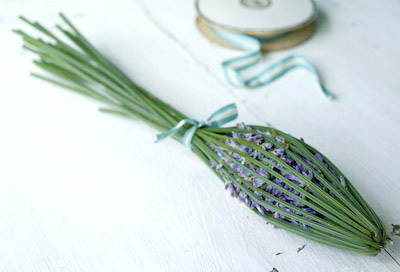
I thought I’d show you another traditional way to store a bundle of lavender, for scenting linens, where the flowers are encased in a cage made from the flower stems woven with ribbon. Called a lavender bottle, made this way, the flowers stay put and don’t go all over the place, so it can be pushed in between layers of stored bedlinen, kept in a drawer with your smalls or hung in the wardrobe to keep your best clothes sweet. For this the lavender variety is immaterial, the smellier the better.
Again pick your lavender on a dry sunny day when the flowers are just about to be or are partly open. The stems need to be long, green and pliable. Pick an odd number of stems, I used 21 here, and bundle them together, so all the flowers are bunched up together and the stems are smooth, pulling off any smaller flowers lower down. Tie tightly together below the flower heads with a piece of thin ribbon or twine. Then one by one, bend the stems back over the flowers so they form a cage around them. You do have to try and arrange the stems as evenly spaced as possible to keep things as neat as you can at this stage.
Tie a piece of ribbon or twine tightly around the stems to hold everything in place. Now, take a long length of narrow ribbon, 5-10mm (1/4-1/2in) wide is ideal, and starting at the top pointy end, wrap one end of the ribbon around one of the stems and fix it in place with a few stitches made with needle and thread. Begin to weave the ribbon in and out of the stems (you may find a bodkin useful to help with this), working round the stem cage and pulling the ribbon evenly to give the lavender bottle a good shape. When the flowers are completely encased by the woven ribbon, tuck the end of the ribbon around a stem and fix in place with a few stitches with needle and thread. Trim the stems to the length you like then tie the stems tightly together with ribbon at both ends. Leave the bottle to dry out for a while and give the flowers a squeeze from time to time to reactive the scent.

Another fab way to scent bedlinen and clothing is to spray them lightly with lavender linen water whilst ironing or just before you put them freshly laundered into the linen or airing cupboard.
SUNSHINE AND SUMMER BERRIES
Wednesday June 08th 2011, 7:30 pm

I’m so glad I made a concerted effort to get the preserving garden allotment sorted out earlier in the season. I’ve been distracted for the last few weeks so the plot has been neglected and there’s now much weeding to be done to make it all neat and tidy again. But sometimes a break is necessary if only to accept that to some degree, what will be will be. Now comes the payoff. The berries are ripening and my longed for supply of strawberries has become a reality.
The other day I picked my first substantial batch and there should be several more punnets full to come in the next few weeks. The bulk of my plants are Cambridge Favourite, which I chose as a classic jam making variety. Planted autumn 2009, there was no fruit to speak of last year and the plants sent out lots of runners, some of which I encouraged to root and establish. The plan was that this year would be the first season to expect any fruit and I’m not disappointed.
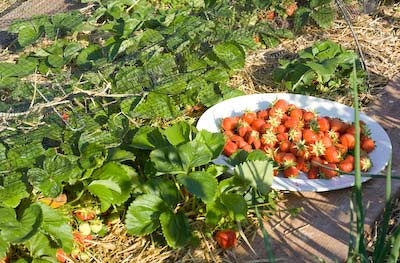
The rule of strawberry picking is to chose a warm dry day for it and, of course, to eat as many berries, warmed by the sun, as you can, right there and then. These berries are just so sweet and packed with flavour. When picked that warmth quickly ‘cooks’ them and they lose their polished look in moments once they are detached from the plant, so you need to get them cooled fast. Even after my seasonal binge there were still 3 kilos of fruit to take home to preserve.
I plan to make jam with subsequent pickings but for this first load I wanted to can compote and syrup, using my harvest as fresh as possible to capture this exceptional flavour. Strawberries aren’t highly rated for bottling as they overcook fast but making compotes to eat out of season to serve with yogurt or vanilla cheesecake or a simple sponge cake with cream …. well, that does it for me. This is were canning makes such sense. Jam is usually overladen with sugar and jam makers often complain that they have far too much of it to consume, but compote can contain much less sugar, so the flavour of the fruit shines through and by water processing it, you can then stock the pantry with jars that will keep throughout the year ahead.
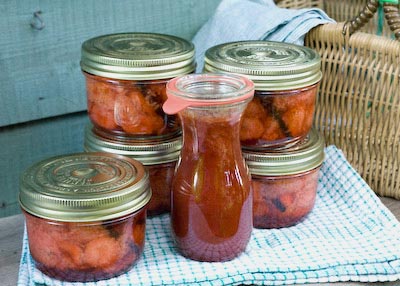
With canning generally, it is important to use jars that are a size that suits how many people you feed. I like to use smallish jars so once opened I know none will go to waste. My next door neighbours brought me these Le Parfait Familia Wiss 350ml jars back from France recently so they looked to be just perfect for the job. I canned the left-over syrup in a 250ml sized Weck flask and there is another half flask, in the fridge for using up now.
The berries need to be macerated with sugar overnight so their lovely juice is drawn out, turning the sugar to syrup at the same time. I wasn’t sure how much syrup the berries would produce but there was enough left over to bottle on its own. This syrup is just fab stirred through Greek yogurt and I’ll be churning some vanilla ice cream soon to make another perfect partnership. The compote will go with just about anything.

STRAIGHT-LACED STRAWBERRY COMPOTE
Makes 6 x 350ml (7 x 1/2 pint) jars compote, plus approx 375ml (3/4 pt) strawberry syrup
3Kg (6 1/2lbs) strawberries
350g (12oz) sugar (adjust to your taste)
2 vanilla pods
1Tbsp balsamic vinegar
Rinse and drain the fruit if you must! As I knew exactly where my fruit came from and that it had been mulched with straw to keep the berries clean and off the soil, I didn’t wash the fruit … so you choose! Remove the stalks and halve the largest berries then place in a large glass or ceramic bowl, sprinkling the sugar in layers between the fruit as you go. Split the vanilla pods and scrape out the sticky seeds then bury the pods and stir the seeds in amongst the berries. Cover the bowl with cling film or a plate and leave in a cool place or the fridge overnight.
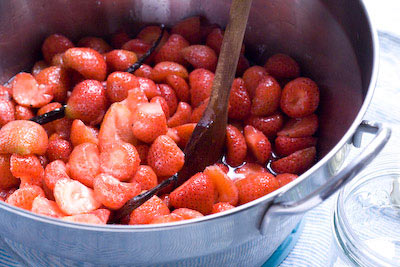
Prepare the water bath, jars and lids for canning*. Pour the fruit, sugar, vanilla and any juice into a preserving pan. Warm it through stirring until all the sugar is dissolved. Add the balsamic vinegar then bring all to a simmer and cook through for 2 minutes. Using a slotted spoon or sieve remove the berries and vanilla pods from the syrup into a warm bowl. This way the softened berries will still be surrounded by syrup. (Some fruit pulp will remain in the syrup. If you want to make a smoother syrup from your left-overs then pass it through a sieve.) Cut each vanilla pod into 3 then using a jam funnel, pack the strawberries into the jars, to come just below the headroom line for the type of jars you are using. Push a piece of vanilla pod down the side of each jar so it shows against the glass. Top up with hot syrup from the pan if necessary, so the berries are submerged.
De-bubble the fruit around the sides of the jar using a narrow spatula or chop stick to release any trapped air bubbles, wipe the jar rims clean and seal. Water process for 10 minutes then remove from the water bath and leave till cold. Check the seals and label your jars ready to store. If any of your seals fail, use the compote as if fresh*.
For the remaining syrup in the pan, bring to a brisk boil for 5 minutes till the syrup is slightly thickened or to your liking. Pour into hot jars to the headroom line appropriate for your type of jar (Weck flasks can be filled almost to the top), tap the jar on the counter to release any trapped air bubbles, wipe rims and seal. Process for 10 minutes then remove from water bath and leave till cold before testing seals are fixed.
*If you don’t intend to water process the compote and syrup it should keep, if refrigerated, for about a week.

PICKLING ASPARAGUS
Monday May 09th 2011, 9:18 am
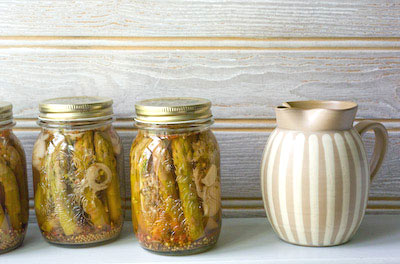
The asparagus season is in full swing. 14 of the 15 crowns planted in my newly prepared asparagus bed have started to appear, sending up very fine spears that then become frothy graceful ferns. They must be left alone for the time being to build up energy and form good sound crowns for the years ahead and I must be patient. I’m hoping the 15th crown is OK and wonder if I could have planted it upside down, and if I did, will it find its way right way up in time?
The other day I came across some bargain priced asparagus at the supermarket that had reached its sell by date, so was going cheap, half price in fact. Recognising a bargain when I see one, I bought up the lot so I could do some pickling. Since the Canjam last year, when other canners participating produced pickled asparagus, I’ve been wanting to experience this preserve first hand, but with this prized vegetable never exactly in abundant supply and always required for immediate scoffing, I couldn’t envisage when the opportunity to pickle some would arise. So watch what you wish for, here was my golden opportunity and I grabbed it with both hands.
I am now the proud owner of 5 x 500ml (1 pint) jars of pickled asparagus. I canned 3 to start with then had the idea to add the last of some wild garlic flowers, picked that day, so canned a couple more jars. I have no intention of sampling these pickles until the memory of the fresh English stuff is a distant memory, as this is not intended as a replacement for what is available in season right this minute. Some pickled spears, served with hard-boiled eggs, a handful of salad leaves and a wedge of homemade bread and butter will be a simple lunch to look forward too in 6 months time.

Fitting the spears into the jars is a wasteful business as they do need to be trimmed especially short to fit. I made asparagus soup with the stem cut-offs, so none went to waste, but shorter dumpier spears to start with makes the task less painful. There is no way I would have wanted to do this if I’d paid top wack for my ingredients.
PICKLING ASPARAGUS
I used 2 x 200g bundles of fresh asparagus spears to fill each 500ml (1 pint) jar, but it will depend how long the stems are and how much stem you’ll need to chop off so they fit into the jars. Allow a few more spears so they can be packed tightly into the jars and cut them so they fit snuggly and sit below the level of vinegar headspace when packed upright in the jars.
For each 500ml (1 pint) jar allow:
400g (1/2 lb) asparagus spears
120ml (1/2 cup) white wine vinegar
120ml (1/2 cup) water
1 tsp dill seed
1/4 tsp chilli flakes
1 tsp sea salt
1 small shallot, finely sliced
1/2 clove garlic, sliced
6 fresh wild garlic flowers (optional)
*Prepare the canning bath and keep your empty jars submerged in there until they are needed. Prepare lids in another pan of simmering water. Blanch the asparagus spears fleetingly in boiling water for 60 seconds, then drain them and cool immediately with cold water, so they don’t cook any further. Mix the vinegar and water in a pan and bring to a simmer.
Place the salt and spices in each jar, then pack the asparagus spears upright (or you can do them pointing down if you like!) in the jars, adding the shreds of shallot and garlic, and the wild garlic flowerheads in amongst them as you go. Pour in the vinegar/water to cover the asparagus, leaving the headroom necessary for your type of jar. De-bubble, to release any trapped air pockets surrounding the spears, using a chop stick or thin spatula. Wipe the jar rims clean and seal. Process for 10 minutes, then remove from the canner and leave until cold before testing the seals.
*Once canned like this your pickled asparagus will keep for a year or even longer. Pickling can be done successfully without hot water processing so long as the acidity of the vinegar / water used is high enough. Canning removes the guesswork!

A SEED PLANTING MASTERCLASS
Saturday April 16th 2011, 11:48 am
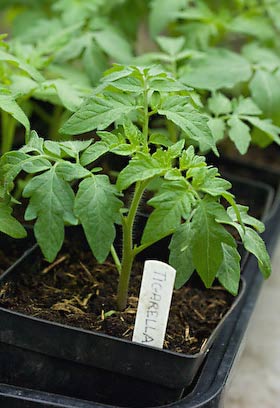
Well this week I managed to get my asparagus bed planted, which felt like no mean feat. The soil needed a lot of attention and I took great care to remove any perennial roots I could find as I sifted through it, as all the books tell you you must. When the asparagus crowns were safely in their straddling positions and covered with earth, instead of feeling a great sense of achievement I was positively down in the dumps; only 2 more years to wait for a crop. Whoopee, roll on 2013! By then I’ll be two years older but hey, I’ll be eating my own homegrown asparagus. I don’t seem to have quite the right attitude, do I?
Anyway, what next? Time to plant some seeds to fill in the gaps around my fruit bushes. I love buying the packets with inspiring pictures of my prospective crops on the front, but you really do have to get them in some compost as they don’t do that themselves. I decided to go visit my friend Shelley, who is a brilliant gardener and font of horticultural knowledge, for a masterclass in seed sowing. She will surely give me the inspirational uoomph I seem to be currently lacking to restore my gardening mojo.

Shelley is really into growing veg. She grows some for her local show and the competitive bug has well and truly taken hold. Her garden is set out in quite a formal way, with geometric shaped raised beds all working towards central focal points, in the style of a classic parterre with finials on every corner. There is a four sided regency arch with a chandelier hanging from the centre which will soon have sweet peas and climbing beans scrambling over it. The difference with Shelley’s planting style is that she fills the beds with vegetables and uses them in a decorative way. So instead of the beds being edged with box hedging, she uses broad beans with green stakes, or leeks growing for showing in terracotta tubes. Each year the planting changes as the crops rotate. She starts her potatoes off in small pots of compost then plants them as part of the pattern, planting and earthing up in one fell swoop. The soil looks amazing and she is the best person I know to consult when I want to know just what particular element a certain crop will need, beit more nitrogen or a little potash to get the best results.

First she showed me some seedlings that she hadn’t grown from seed. Both of us seem to have arrived at the point where we have realised it can be unproductive to want to grow absolutely everything. Sometimes being over ambitious can be a problem. Though we both share a love for unusual plant varieties we’ve concluded it’s better to grow a good classic, great tasting spud than some weird purple sort that only looks good in a photo. There is always room for experimentation but the best flavoured crops are now a priority. Shelley has some dill seedlings that were bought as one pot from Homebase which she then split to make six very healthy looking plants. That would suit me fine too. I need some dill for my pickling, so this would also work well for me. No need to always invest in a whole packet of seed.

Next she planted up a tray of her special Serbian pole beans. She’d been given this bean some years ago and saves more seed each year. This bean apparently has a very fine flavour, can be eaten fresh but stores well when dried. Perfect for my preserving garden. The compartments of a recycled seed tray were filled with Shelley’s specially mixed seed compost and a bean was pushed into each one, covered with a bit more compost, et voila, that was easy enough.
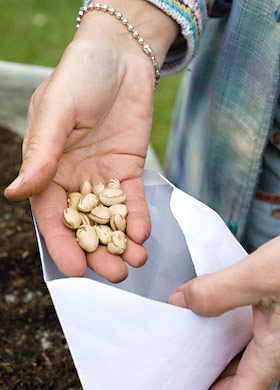
Shelley showed me her trick for broad beans, where she germinates the beans in a plastic bag partly filled with compost, just throwing her handful of beans inside, tying the bag and placing it by her Rayburn for a few days. It is also a good way of testing the viability of the seed if it has been hanging around for a while. This means that only germinated seeds get planted and avoids any gaps in the rows that you sometimes find when planting straight into the ground.
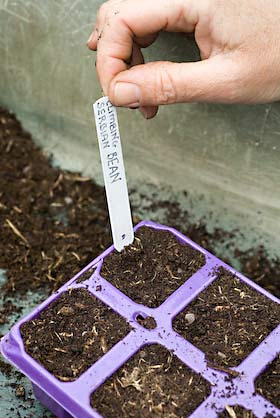
Seeds that traditionally would be sown straight in the ground and resent root disturbance can still be started off in pots, but for these a biodegradable pot works best. Beetroots and parsnips fit into this category. Shelley had some paper pots already made from newspaper for this job using a paper potter. The beetroot seeds contain several seeds in a cluster, so it is only necessary to put one seed per pot. By the time they are ready for planting out the newspaper will easily disintegrate and allow the roots to work their way out into the surrounding soil.
As the rows of seeds were sown each was labeled to avoid any confusion later on. All the seeds were lightly covered with compost except some romanesco brassica seeds that like to be planted on the soils surface. For these a light sprinkling of vemiculite neatly finished them off. All the seeds were given a sprinkling of water from the watering can then placed out of the way to germinate, in Shelley’s case on a shelf in a cold greenhouse.

So spurred on I set of back home, my tray of Serbian pole beans on the car seat beside me as well as a globe artichoke plant and a bunch of freshly picked lovage. I’m now feeling full of enthusiasm to get planting. As Shelley opened the gate for me to drive away, I thought I’d give something back in return and handed her a very healthy looking Jerusalem artichoke that just happened to be sitting in a bag in the car, recently collected from someone on Freecycle, who had offered them for free. They are the plumpest, healthiest artichokes I’ve ever seen in my life! Shelley was also suitably impressed with their quality and happily accepted my gift. That’s the great thing about gardeners, simple things can mean such a lot.
RHUBARB FLOWER SPOTTING
Friday April 08th 2011, 4:09 pm

Everybody’s rhubarb seems to be going to pot round here, going to seed and throwing up flower heads. Any rhubarb lover worth their salt will of course cut them off as soon as they appear so as not to exhaust the plant, like I showed in my last post and also wrote about here. Some people just don’t care and leave this vegetable to do its own thing. I must admit I love the sight of towering rhubarb flowers but love the taste of rhubarb more (this is starting to sound like a Harry Hill ‘F-I-G-H-T’). As I’ve got big preserving plans for my own homegrown rhubarb I am happy to leave the flower cultivation to others.
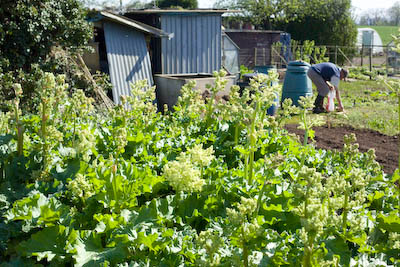
I have often noticed some rhubarb growing on an allotment in the village. It forms a particularly lush band going right across the width of a plot. Today I saw that it was all in flower so decided to stop to take some pictures. The old guy whose plot it is, thought I had stopped to request some rhubarb, as he doesn’t eat it! He said he sowed a packet of seeds three year ago, a variety of which he had no recollection, and this is what resulted. As far as he was concerned he’d be happy to get rid of the lot.
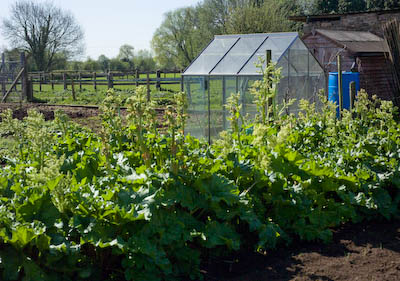
I have seen the flowers on sale in London as a cut flower. Can’t imagine them being popular round these parts but it’s a shame as the flowers, though strangely triffid-like, are rather grand and statuesque. I cut one off a plant in my garden and have it currently on my mantelpiece as a cut flower in a vase. They are big heavy blooms with hollow stems and like other cut flowers with hollow stems you need to hold them upside down and pour water into them till full, then bung up the end with a piece of cotton wool, before returning to upright and placing in a good heavy, topple-proof vase filled with water. The flower seems to be continuing to grow day by day, which is rather spooky.

THE PRESERVATIONIST’S PLOT
Monday March 28th 2011, 5:32 pm
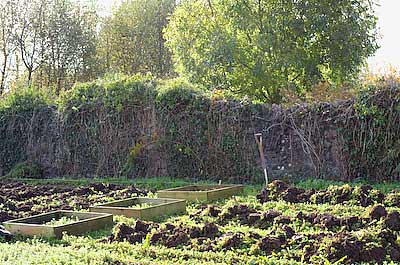
I am writing this post to cheer myself up. I’ve been busy knocking my allotment into shape for the growing season ahead and I think I’ve overdone it. Somehow no matter how much I dig and how many hours I spend trying to get through the jobs on the list, they just never get all ticked off. I’m the same with decorating the house. It is only once the job is completed that I feel the slightest glimmer of hope. So with still loads to do I decided to look back to see how far the plot has come since I first wrote about it here on my blog in October 2009. Looking at my original ‘before’ pics is helping me recharge so I can get out there some more.

I set out to plant a garden specifically with preserving in mind, so the bones of the plot are my fruit bushes; blackcurrants, gooseberries, white, pink and red currants, strawberries in abundance and rhubarb even more abundant. There’s a row of blueberries as well as raspberries and angelica, a mirabelle plum tree and an old English greengage. So the second season begins on an optimistic note even though I am momentarily gloom and doomy.

Thing is there is still a whole lot needs to be done. I’ve ordered asparagus crowns so their patch needs to be well and truly weeded and ready when they arrive in the next few weeks. The stone wall that bounds two sides of the plot has been cleared of ivy and I plan to plant along it, with some espaliered fruit trees, like apricot, fig and cherry along the top edge, where the most sun reaches. The ground along the wall is full of the roots of the ivy, nettles, ferns, ground elder and brambles, so the clearing out involved is quite exhausting and I’m impatient for it to be sorted so I can plant this season. That is the part of gardening that does my head in, learning to be patient and accepting the limitations that time allows.
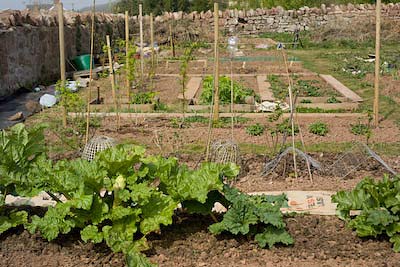
I’m quite pleased with the layout of the plot. The beds are all rectangles and squares made up as I went along, so the look is quite orderly but asymmetrical at the same time. I bought a job lot of old scaffolding planks last year intending to use them to edge the beds but I’m liking them laid down to form the paths between the beds with some hessian coffee sacks also covering some of the paths like fitted carpet. They’ve been pegged down with bent wire pins and will last for a year, hopefully longer, but in the meantime give the plot a nice tidy look and keep the weeds away. We have problems with rabbits and pheasants on the site, so you have to be on the defensive whenever anything is planted. Happily, there are fewer slugs and snails than I’ve ever experienced before.

With April upon us, it is now time to plant some seeds to fill in the gaps around the fruit. I’ve got some straightneck squashes to sow, that I loved in bread and butter pickle last year, dill for more pickling and borlotti beans for drying. My garlic for pickling scapes is growing well and hopefully the rabbits won’t take a shine to it.
The rhubarb is doing splendidly. I’ve harvested a few stalks already and will have more in the weeks ahead even though I need to go easy on the cropping as this is still early days. I think next year it will come into its own and again some patience is called for. Today I noticed there were a few flower heads starting to form, so it was necessary to cut them off so the plants don’t waste their energy needlessly.

I have high hopes for the strawberries planted last year. Fingers crossed they will do well this year and the preserving pan will be ready and waiting when they do (and some will be consumed fresh as well of course). I haven’t finished weeding the second strawberry patch yet and already have plenty of little plantlets potted up ready for a new home in my garden. Well, I’m feeling cheerier already. I’d best get out there and continue with the digging.
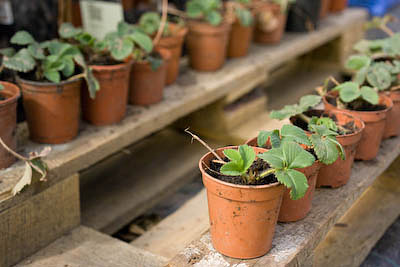
RHUBARB, BLUEBERRY & LIME JAM
Tuesday March 01st 2011, 1:39 pm

Last week I posted on the Guardian Organic Allotment blog and, though seemingly out of season berry-wise, wrote about planting blueberry bushes for jam. The recipe I included for rhubarb, blueberry and lime jam is a real favourite of mine, so to keep things in order and so’s regular readers don’t miss the recipe, I’m posting it here as well.
I only ever have small quantities of blueberries to play with but this recipe makes a little go a long way when used in combination with rhubarb and they add such a great colour to the jam. I buy up reduced priced punnets at the supermarket when I find them for a snip, up to their use by dates but still nice and fresh, then I freeze them to add to muffins, pancakes and jam. In summers to come, I hope to have a plentiful supply of my own berries, from the bushes I’ve just planted on my allotment. I’d much rather use ingredients that come from down the road rather than the other side of the planet. Well that’s the idea anyways.
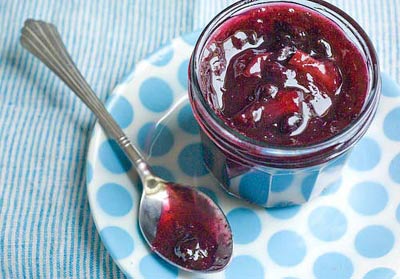
RHUBARB, BLUEBERRY AND LIME JAM
Makes 1.25kg (2 3/4lbs)
600g (1lb 6oz) rhubarb
300g (3/4 lb) blueberries
2 limes, the zest and juice
700g (1lb 8oz) sugar
Wash rhubarb, top and tail then chop into evenly sized pieces (I usually run a knife down the middle of the stalks then chop into roughly 1cm sized pieces). Place in a glass bowl and pour the sugar over the top. Cover with a plate or cling film and leave overnight, by which time the sugar will have soaked up the juice from the rhubarb.
Place the grated lime zest and blueberries in a pan, adding 3 Tblsp of lime juice. Heat gently and simmer for 15 minutes with the lid on, until the berries are cooked and surrounded by juice.
Prepare your canning bath and jars if planning to hot water process your jam, or put clean jars and lids in a cool oven for 20 minutes to heat and sterilise them.
Pour the rhubarb and sugar into a jam pan and stir over a low heat until the sugar is completely dissolved. Add the blueberries and lime, turn up the heat and cook at a rolling boil until setting point is reached (a small dollop of the syrup on a cold plate will readily form a skin when left to cool slightly). It took me 10 minutes to achieve this and I advise that you keep an eye on it and give the occasional stir whilst it cooks as the mixture is apt to burn if you’re not careful. Skim if necessary. Pour into hot sterilised jars, put a circle of waxed paper on the surface of each one and seal. Alternatively, pour into hot canning jars leaving the correct headroom for your type of jars, seal and process in a water bath for 10 minutes.
This jam has a nice soft set that suits me fine. If you prefer your jam to ‘cut’ rather than dollop substitute all or half of the sugar with preserving sugar that includes added pectin.
I PUT MANURE ON MY RHUBARB
Sunday February 13th 2011, 1:10 pm
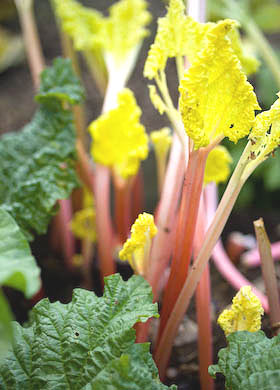
‘I prefer custard on mine’ …. I hear you reply!
Popping by the allotment, it is lovely to see the knobbly buds of rhubarb starting to push their way through. There is a rabbit nibbling problem at present, and like an arm wrestle between vegetable and animal, currently teetering in the rabbits favour, I’m confident that once the rhubarb gets a spurt on, the plants will win hands down and see off the fluffy predator.
The plot is fast beginning to resemble the national rhubarb collection, as I just can’t resist adding another variety when I come across one, conveniently forgetting that each crown will eventually take up a wacking great amount of space as it becomes established. Ho hum, who cares? All these varieties rarely mean much difference as regards taste, but for a rhubarb nerd it means you can admire the subtle variations of habit and leaf shape.
One variety I sought out especially, having grown it before on my London plot, is Livingstone, named after Red Ken. This variety is particularly useful as it has had the dormancy bred out of it, so gives a crop right through until the first frosts, unlike the others that you should stop picking in the summer months. You aren’t likely to find Livingstone for sale as it is produced under license so shouldn’t be propogated as the rights belong to the breeder, who I bought the original cultivar from, then years later tracked him down again and begged him to send me another crown (it is amazing how begging usually does the trick).
This is why there is no need to import rhubarb in the UK. We have the varieties available to harvest, virtually all year round. It always amazes me when I see rhubarb for sale in Tesco imported from New Zealand. My nearest independent greengrocers, usually sell Dutch rhubarb as the much lauded Yorkshire stuff is hard to source at the market or when found is too expensive for them. Now in my second year on the plot, I should be self sufficient in the stuff very soon, so such concerns will be for others to wrangle over.
It’s great that rhubarb is seeing a renaissance. I hadn’t eaten forced rhubarb until fairly recently, so I loved it before all the guff about not stewing it and that only the sweeter pink stems are worth having, bla-di-bla. The pinker it is the prettier it looks and you can juice it too, but for a diehard rhubarb fan brought up on stronger stuff, it is simply an hors d’oeuvres, leading the way to the main course.
Luckily, as one of my favourite flavours, when it comes to rhubarb, if you say ‘glut’ then I say ‘bring it on’. I may well become famous for my rhubarb ketchup, one day, but in the mean time here is a recipe for pink grapefuit, rhubarb and cardamom marmalade that I developed last year that usefully has a longer seasonal ‘window’ that the usual Seville orange sort and also just happens to taste great. The recipe doubles up fine if you want to make a bigger batch.
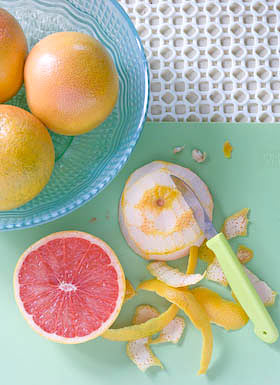
PINK GRAPEFRUIT, RHUBARB & CARDAMOM MARMALADE
Makes approx 1.3Kg (3 lbs)
0.5Kg (1.1 lb) rhubarb
1kg (2.2lbs) sugar
juice of 1 lemon
seeds from 10-13 cardamom pods, crushed
3 pink grapefruits, approx 750g (1.65 lb )
Rinse the rhubarb stems and chop into 1cm (1/2 in) evenly sized pieces. Place them in a bowl with the sugar and lemon juice. Tie the cardamom seeds in a piece of muslin and push them inbetween the rhubarb, then cover with baking paper or clingfilm and leave for a few hours or overnight, so the juices begin to soak into the sugar.
Wash the grapefruit and remove the peel with a sharp knife or potato peeler, leaving as much of the pith on the fruit as possible. Finely cut the peel into shreds. Squeeze the fruits and collect the juice and tie the remaining pulp, pith and pips together in a muslin bundle. Place the shreds, juice and bundle in a pan, add 1.4ltr (2 1/2pt) water and simmer for 1 1/2 – 2 hours until the peel is cooked through and tender. Remove the muslin bundle and, when cool enough to handle, squeeze the juice from it back into the pan, then discard. Pour the peel through a sieve and collect and measure the liquid, adding more water if necessary to make it up to 1ltr (1 3/4 pts).
Prepare the jars and canner if you plan to hot water process the marmalade, otherwise, make sure your jars and lids are clean and place them in a warm oven to heat and sterilise. Place the cooked shreds, cooking liquid and the contents of the rhubarb bowl in a preserving pan and bring slowly to the boil, stirring to make sure all the sugar is dissolved. Bring to a rolling boil and cook on a high heat until setting point is reached, that is when a small blob of the syrup on a cold plate quickly forms a skin when you run your finger across the surface. Remove the cardamom bundle.
Fill the jars, leaving the appropriate amount of headroom for canning, and seal. Hot water process for 10 minutes, then remove from the canner, leave till cold and test that the lids are sealed. Label and store. Alternatively, without canning, place waxed paper discs on the surface of the marmalade and seal. This marmalade should store safely without canning, but hot water processing will make doubly sure that your jam will keep and store without a hitch.

THE GREATEST SCAPES – PLANTING GARLIC
Thursday November 25th 2010, 1:48 pm
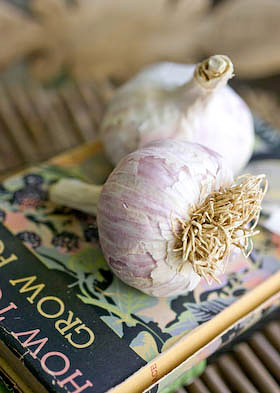
Though parts of the country have had snowfall overnight, here in the Forest of Dean, it may be crisp and cold, but the sun is shining. I really must get my garlic planted today. I bought two bulbs a month or so ago from Dobies; Garlic Vayo, a hardneck variety for Autumn planting, and was really pleased when the plump healthy bulbs arrived in the post. Hardneck garlic varieties need to be planted now so that they experience at least two months of the cold and frost they need to form their cloves. They are also the kind you need to grow if you want to be able to harvest garlic scapes, the winding flower stems they throw up that are a delicacy when pickled.
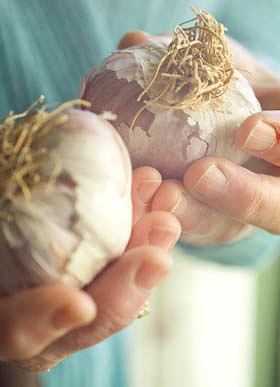
I always associate garlic scapes with Elspeth Thompson. Elspeth, in case she isn’t familiar to you, was an amazingly talented and beautiful garden writer, who tragically died earlier this year. I can’t really call her a close friend but I did get to know her to some degree over the last few years. Elspeth lived a few streets over from me in Brixton and I knew which was her house, even though I didn’t know her. When I took on my first allotment, her book The Urban Gardener, a compilation of her weekly newspaper columns in the weekend Telegraph, became my bible and as it was written in a diary format, I could dip into it and look up the features that Elspeth had written about for a particular week. She was ahead of the game, always. She started to write about her allotment well before growing your own veg in the city became the most fashionable thing to do. I knew where her allotment site was and that she walked her dog in the park that I lived alongside. I knew people who were her friends but I never actually knew her.
After I left London, one day out of the blue, she sent me an email asking me if I knew anything about pickling garlic flowers. She had eaten some at a wedding and thought they were fantastic. Wow, it is quite a thrill when someone you’ve admired from afar just happens to get in touch. Embarrassingly I knew ****all about garlic flowers but in true journalistic style I soon found out and sent her back lots of information. And so began our ongoing email correspondence.

All my research was not for nothing. The flowers, actually known as scapes, are never found for sale in the UK so growing your own is the only way to experience them. So now is the moment when you need to get planting if you are to have scapes to pickle next year. Choose a suitable hardneck garlic variety and plant the individual cloves in drills, 10cm (4in) apart with 20cm (8in) between rows. You can use a dibber to make holes to drop them in, making sure they are sitting the right way up with the root end underneath. Cover with 25mm (1in) of soil. You should have green garlic to lift next May/July and hopefully plenty of scapes to pickle as well.
Dear Elspeth, you will always be in my thoughts as I plant garlic now and in the years ahead and admire jars of pickled scapes on the pantry shelves. You were a truly amazing, inspirational and beautiful person. As a gardener I’m sure you would understand this unconventional tribute.
